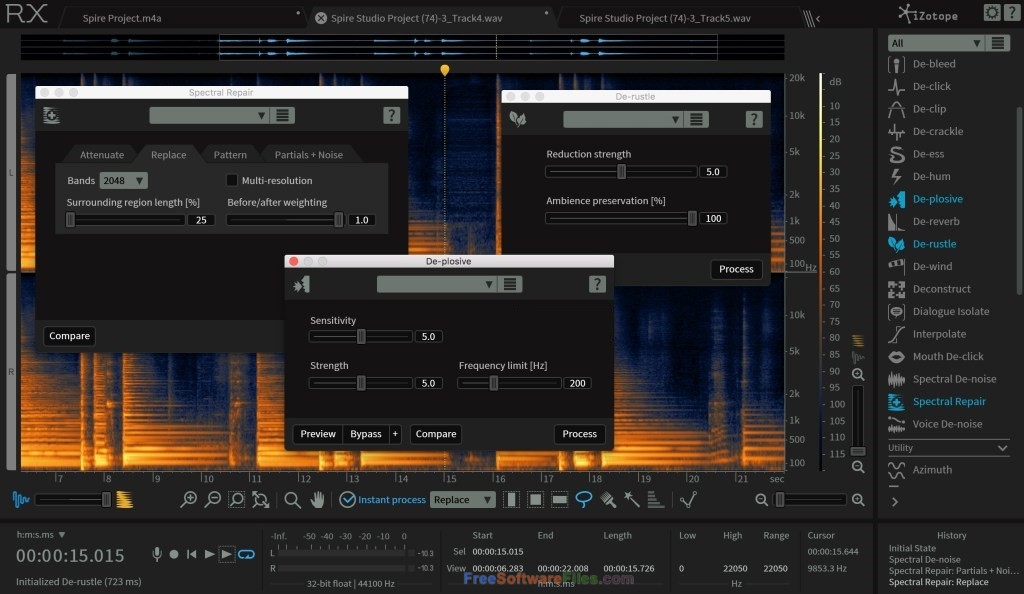Remove Hum Izotope Rx
- Feb 09, 2015 RX 4’s visual editing tools make it easy to identify and remove unwanted sounds captured during the recording process. Download your free, 10-day trial: http.
- Since 1979, Sweetwater has been committed to giving music makers the ultimate shopping experience. Whether it’s our helpful advice - personalized to you.
- How do I remove iZotope RX 2? On the Start menu (for Windows 8, right-click the screen's bottom-left corner), click Control Panel. Windows Vista/7/8: Click Uninstall a Program. Windows XP: Click Add or Remove Programs. When you find the program iZotope RX 2, click it, and then do one of the.
- Sep 19, 2018 Over 10 years and millions of audio rescues later, RX 7 heralds a new frontier in audio repair with features to enable source separation, adaptation of dialogue takes, the ability to automatically.
Apr 24, 2017 DeRustle: Removing Lavalier Microphone Noise with Deep Learning Posted on April 24, 2017 By inconspicuously attaching on clothing near a person’s mouth, the lavalier microphone (lav mic) provides multiple benefits when capturing dialogue.
Output hum only - outputs the difference between the original and processed signals (suppressed hum)
Frequency Type - sets the base frequency of the hum to be removed. The two most common base frequencies that cause
hum are 50 Hz (Europe) and 60 Hz (U.S.). Other base frequencies can be selected by choosing the 'Free' option.
Note: When the Remove Hum module's 'Frequency Type' is set to 'Free', you can use the Spectrum Analyzer (under 'View -> Spectrum Analyzer') and it's peak readout display to help find the exact peak frequency of any unwanted hum.
Learn - analyzes the current audio selection in order to automatically locate and set the base hum frequency.

Izotope Rx 7 Torrent Windows
Digital DSP: enables linear phase filters

Base frequency (Hz)- this slider is only enabled when the Frequency Type is set to Free
Filter Q - controls the bandwidth of filters for base frequency and harmonics
Enable highpass filter: allows high frequencies to pass while attenuating lower frequencies.
Highpass frequency(Hz) - sets the cutoff frequency for the filter
Highpass Q - sets the bandwidth of the highpass filter
Izotope Rx 7 Crack
Enable lowpass filter: allows low frequencies to pass while attenuating high frequencies.
Lowpass frequency(Hz)- sets the cutoff frequency for the filter
Lowpass Q - sets the bandwidth of the lowpass filter
Num Harmonics: select the number of harmonics that need to be removed (1-8)
Linking Type: here you can choose to link the gain/suppression of all of the filters, none of the filters, or odd/even filters
Izotope Rx Rapidshare
Harmonic slope - when harmonics are linked, this controls the slope of the gain/suppresion. As the harmonic order increases the gain/suppresion level resolves closer to 0 dB.
Izotope Rx Reviews
Harmonic even/odd slope - when linking type is odd/even, this allows you to control the amount of gain/suppression for both odd and even harmonics
Filter DC Offset: this removes the DC (direct current) offset that is caused by the imbalance that sometimes occurs in A/D converters. DC offset is exhibited by the waveform appearing above or below 0 dB.
Harmonic gains (dB): gives numerical readout of gain settings in dB. You can also manually type in your gain settings for any of the harmonics.
Izotope Rx 7 Free Download
Standalone Workflow
Remove Hum Izotope Rx300
- Open the audio file in the RX Audio Editor or send it via RX Connect.
- Open the Corrective EQ module [Option+Shift+7].
- Engage a high-pass filter to remove the most apparent rumble and to make any other static filtering gestures before applying the De-noiser. In this example, we also reduced some of the prominent ‘S’ frequencies around 7 kHz and a tonal component of the background noise around 800 Hz.
- Then open the De-noise module [Shift+4]. The De-noise module has two modes: Dialogue and Spectral. We’ll use Dialogue mode for this example.
- Inside the Dialogue tab, we can set the De-noise algorithm to adjust automatically (which is used for sounds that vary throughout the program), or we can manually learn a noise profile that the algorithm can reduce constantly across the program. Since this example has steady background noise throughout, we’ll start in Manual mode.
- Now we’ll Learn a noise profile by selecting a passage of at least one second of pure noise in your audio and clicking Learn.
- The six Threshold Nodes will automatically set themselves based on the noise profile. These nodes represent different parts of the frequency spectrum, and their thresholds can be adjusted (and automated) individually.
- Click Preview and adjust settings to the program material, starting with the Reduction slider and then adjusting multiband threshold nodes if necessary.
- Once you have arrived at the optimal setting for your audio, click Process.